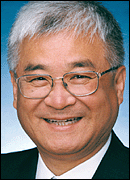

![]()
Pacific Perspective


![]()
Pacific Perspective
Where is the
U.S. leadership
in East Asia?While participating in a conference on the reconstruction of Afghanistan in Tokyo last month, Treasury Secretary Paul O'Neill made the U.S. position toward Japan's ailing economy known to its government leaders.
He pointed out that a weakening yen could neither fix the non-performing loan problems of the banking sector nor improve corporate productivity rate. He further urged the Japanese government to take decisive actions to solve various structural problems facing Japan's economy. He also warned that protectionist measures, including artificially depreciating the yen, only weaken the economy.
Although Secretary O'Neill's remarks clearly defined the U.S. position vis-à-vis Japan's economic reforms, the U.S. government's vision toward the entire region's economic and trade issues remains unknown.
The Asia-Pacific Economic Cooperation summit meeting in Shanghai, China, in October was an appropriate international forum where President George W. Bush could have presented his vision on what the U.S. government could do for the region in the aftermath of the financial crisis in East Asia.
A U.S. initiative for the region was desperately needed considering two major policy blunders committed by the Clinton Administration while handling of the East Asian financial crisis; intervening in the Thai crisis in a lukewarm manner and pushing the International Monetary Fund too far for U.S. self-interests, which alienated members of the Association of Southeast Asian Nations as well as other East Asian countries.
Unfortunately, President Bush's anti-terrorism agenda overshadowed APEC's own agenda of trade and regional integration in Shanghai, leaving many Asian leaders wondering if the U.S. government has formulated any economic and financial policies toward East Asia.
A serious leadership vacuum exists in the region especially on the economic front. Both China and Japan are preoccupied with their own domestic economic reform programs, while other Asian economies are too small to take on a leadership role. As a result, a number of regional issues remain unresolved or unexplored, including the Asian monetary fund, regional financial market integration, Asian common currency, creation of a regional bond market and a free-trade zone.
The U.S. government's position toward these regional issues has been either unsympathetic or uncooperative. This may be attributed to an inward-looking attitude or a myopic view that ignores large potential gains the U.S. economy can enjoy by actively leading any regionalization effort in the Asia region.
A short-term liquidity facility created by the ASEAN + Three (China, Japan and Korea) and the North East Asian trade zone plan are the manifestation of regional integration under progress, while the U.S. presence is conspicuously missing.
It is time for the U.S. government to play a leading role in regional integration, rather than a spoiler's role in hindering more opportunities for U.S. businesses.
S. Ghon Rhee is the K. J. Luke Distinguished Professor of International Finance and Banking at the University of Hawaii at Manoa. He can be reached at rheesg@hawaii.edu.